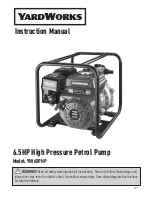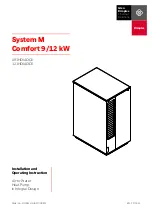
13
PRELIMINARY VERIFICATIONS
WARNING
Verify that the data shown on the plate, and in particular, power, frequency, voltage, absorbed current, are compatible with the
characteristics of the electric line or current generator available. In particular, the voltage of the line voltage can have a variance
of ±5% from the nominal voltage value on the plate.
Verify that the protection and insulation grade indicated on the plate are compatible with the environmental conditions.
Verify that the chemical/physical characteristics of the liquid to be moved correspond to those speci
fi
ed on the order.
Verify that the pump has not been exposed to the weather inclemency.
Verify the environmental conditions: SAER pumps can be installed in enclosed or, at any rate, protected areas, with maximum
ambient temperature of + 40 °C in a non-explosive atmosphere.
Contact the customer care in case of ambient tempe40°C or altitude over 1000m above sea level.
The connection to the power grid must be done in the respect of the local and national standards of the electric system of the
place where the pump is installed.
The waterwork connections must be done according to the local and National regulations referred to the water system.
WARNING
Verify that the pump’s
fl
ow rate and head correspond to the required characteristics.
Before connecting the pipes to the relative openings, make sure that the rotating part of the pump turns freely and is not hindered.
In case of problems please contact our technical assistance servicing.
WARNING
PMK series of pumps: the useful output power provided by the engine must be above the power absorbed by the pump.
ATTACH THE PUMP/ELECTROPUMP TO THE GROUND
The electric pumps can be positioned with horizontal or vertical axis always with the motor upwards. The operatine characteristics of the catalogue
and label are to be understood for continuous service and with clear water (speci
fi
c weight = 1000 kg/m
3
) with a max manometric suction height of
approximately 1,5 m. For higher manometric heights and up to a max of approximately 6-7 m., the characteristics decrease in the various delivery data.
WARNING
The pump/electropump must be installed as close as possible to the suction point of the liquid.
WARNING
Make sure that the pump’s support surface is solid and even (so that it rests on all the feet) and that the load capacity of the
surface is adequate for the weight shown on the plate.
Verify that the surrounding area is suf
fi
cient for ventilation and allows movement in the case of maintenance.
Select suitables point and area of
fi
xing: verify the prevention of possible vibrations to the surrounding structures.
Check that the strength of the concrete foundations is appropriate and complies with current relevant regulations.
Pumps must be
fi
xed through the base feet. In case of horizontal positioning the pumps must be equipped with suitable
supports.
CONNECTING THE PIPES
WARNING
The available NPSH value in the lifting plant must be always bigger than the pump’s NPSH (Table VI), both in installation under
head and over head in order to avoid cavitation.
As far as hot liquids are concerned, NPSH must be re-calculated, in order to obtain the required head in any case.
WARNING
The pump maximum working pressure (TAB.II) can’t be bigger than the PN pump nominal pressure.
WARNING
Pipes must be suitables for the pump maximum working pressure (TAB.II).
WARNING
The intake and delivery pipes must not transmit forces to the pumps/electropumps due to their own weight and/or heat expansion,
at the risk of possible liquid leaks or breaking the pump. For this reason, the pipes must be supported by anchorages and, if
necessary, expansion joints must be inserted in the appropriate positions.
Pumps don’t have to transmit vibrations to the pipes, therefore insert anti-vibration couplings both in suction and delivery.
WARNING
Install non return valve on the discharge side
Install gauge valve both in suction and discharge side.
The intake pipe must always be perfectly air tight and not positioned horizontally, but must always rise towards the pump (
fi
g. 3). On the other hand, in
the case of operation under water head, the intake pipe must always slope down towards the pump (
fi
g. 4). For this reason, any
fi
tting cones 1 must be
eccentric and oriented as shown in the
fi
gure to avoid the formation of bubbles during priming or operation.
It is a good idea to protect the pump by inserting a
fi
lter on the intake pipe; especially during the initial period of operation, the pipes release slags capable
of damaging the pump seals. The
fi
lter must have a mesh less than 2 mm and a free passage area of at least 3 times the section area of the pipe so as
to avoid excessive losses of head.
To adjust the
fl
ow rate, it is a good idea to install a shutter on the delivery pipe.
The diameter of the pipe must be such that the speed of the liquid never exceeds 1,5 - 2 m/s at intake and 3 – 3,5 m/s at the delivery. In any case, the
diameter of the pipe must not be less than the diameter of the pump openings.
The suction piping must be absolutely hermetic and for the catalogue data
it must have the following minimum diameters (pipes of smaller diameters reduce the delivery values):
DN
(pump suction) - mm
DN
(suction pipe) - mm
DN
(pump suction) - mm
DN
(suction pipe) - mm
32
50
65
100
40
65
80
125
50
80
100
150
Содержание PMK Series
Страница 5: ...5 8a MK 32 32 R 40 40 R 50 1 2 3 8b MK 65 1 2 3...
Страница 34: ...34 5 30 6 0 03 A 4 90 6 i ii iii iv v vi i ii iii iv v vi 30 30 40 C 90 C 55 C 50 c 10...
Страница 35: ...35 7 SAER SAER MK32 40 50 65 7b MK32 40 50 65 7a 7b MK32 40 50 65 8 8 9 NPSH 10 SAER...
Страница 37: ...37 PMK 32 PMK 32R PMK 40 PMK 40R MK40 MK40 R...
Страница 38: ...38 PMK 50...
Страница 39: ...39 PMK 65...














































